State of the economy: February 2019
Report produced tri-annually by the Chief Economic Adviser to provide a picture of the Scottish economy in an international context, including Brexit impact analysis.
Scottish Economy Update
Gross Domestic Product
Scotland’s economy continued to expand into the second half of 2018, building on the period of strengthening growth over the previous 18 months.
Latest data for Q3 2018 show the economy grew 0.2% over the quarter - its seventh consecutive quarter of positive growth – and 1.3% over the past year. In both cases, the pace of growth was slightly slower than in the previous quarter, however, on an annual basis growth is broadly in line with the UK.
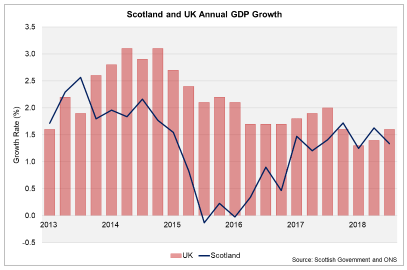
Over the past year, growth was broad based across the Services, Production and Construction sectors. Over the third quarter, growth was driven by positive growth in the Services (0.2%) and Construction (2.9%) sectors, offsetting a contraction in the Production sector (-0.9%).
In the Services sector, there was positive growth across Business Services and Finance (0.4%), Transport, Storage and Communication (0.6%) and Government and other services (0.1%). This offset a slight contraction in the Distribution, Hotels and Catering sector (-0.1%) driven by a contraction in the Retail and Wholesale sector (- 0.5%).
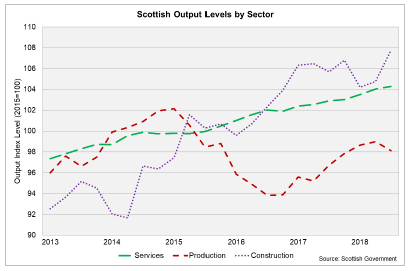
The contraction in the Production sector has followed a number of quarters of strong growth. The fall in output was relatively broad based with contractions across Manufacturing (-0.9%), Electricity and Gas Supply (-1.7%) and Water Supply and Waste Management (-0.7%) offsetting growth in the Mining and Quarrying Industries (0.7%). The largest negative contribution to growth came from the Manufacturing sector, and in particular, the Food and Drink sector.
Developments in the oil and gas sector have had a material impact on the Production sector over recent years. The latest survey data from contractors in the sector report increasing levels of business confidence and activity through to October 2018.[1] By supporting activity in the wider supply chain, this increase in confidence and activity directly boosts output in the production and manufacturing sectors in Scotland and feeds through to the wider economy. However, conditions in the sector remain challenging and the recent decline in the oil price back to around $60 per barrel in the new year has the potential to impact sentiment going forward.
Exports
Stronger global growth, alongside the weaker value of Sterling has fed through to stronger export growth.
This can be seen in manufactured exports which make up around half of the total value of international exports from Scotland’s onshore economy.
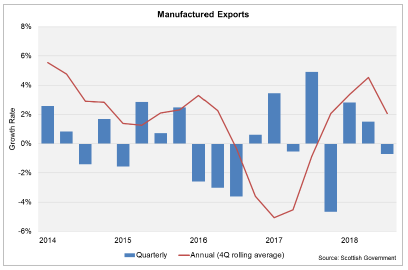
Manufactured exports grew 2.1% over the past year (on a rolling annual basis), however the pace of growth has slowed over the year and contracted in the third quarter (-0.7%). This likely reflects the broader slowdown in manufacturing output over the quarter and the slight easing in momentum as the impacts of lower Sterling feed through and growth in the global economy softens.
The main driver of the slowdown in manufactured exports over the past year was in the Food and Drink sector, which saw volume of exports fall by -0.4%, while the pace of growth of exports from Refined Petroleum, Chemical and Pharmaceutical Products (8.5%) and Engineering, Metals and Machinery (3.7%) slowed.
More disaggregated, but less timely, export statistics for Scotland were also published last month in the Export Statistics Scotland report. This provides estimates of exports for all sectors of the economy, and for all export markets for 2017. The key results from the report are summarised in the following box.
Scotland’s International Exports[2]
The latest Export Statistics Scotland publication provides estimates of Scottish international exports in 2017 (excluding oil and gas).
Scotland’s international exports increased by 6.2% in 2017 to £32.4 billion – the highest annual growth rate since 2011.
The majority of this growth in 2017 was in exports to EU countries with exports to the EU up 13.3% over the year to £14.9 billion. Scottish exports to non-EU countries saw slower growth, increasing by 0.8% over the year to £17.6 billion.
The EU continues to be Scotland’s largest single market for international exports accounting for 46% (£14.9 billion) of Scotland’s international exports. At a country level, the USA continued to be Scotland’s top export destination country with an estimated £5.5 billion of exports from Scotland in 2017. The top five international export markets (USA, Netherlands, France, Germany and Ireland) accounted for £14.3 billion (44%) of international exports from Scotland in 2017.
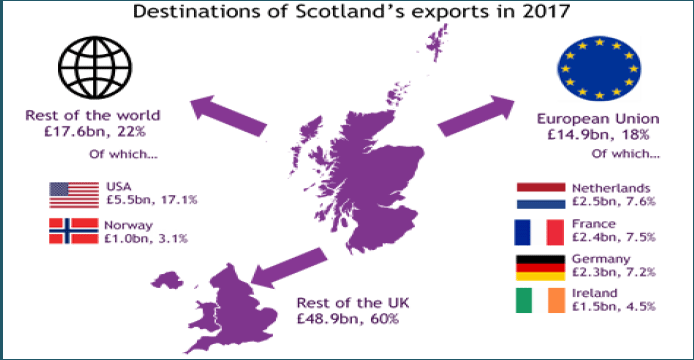
At a sector level, manufacturing exports performed well, up 10.3% over the year to £17.6 billion. This was supported by strong annual growth in exports of refined petroleum and chemical products (+35.6%), computer, electronic and optical products (+41.1%) and transport equipment (+15.2%). Exports from the manufacture of food and drink also increased over the year (+8.4%), underpinned by strong whisky exports, and continues to be the largest industry in value terms of international exports in Scotland.
Exports of services also increased in 2017, though at a slower rate of 0.6% to £12 billion. Over the year, there was strong growth in exports from the information and communications sector (+35.6%) and financial and insurance activities (+8.8%). Exports of professional, scientific and technical activities fell 7.0% over the year – though remains Scotland’s second largest international exporting sector – as did exports from the wholesale and retail trade sector (-6.1%).
Retail Sales
The Scottish Retail Sales Index provides the first output data for Q4 2018 in Scotland. It showed that the pace of annual retail sales growth in Scotland picked-up in the final quarter of 2018 to 1.4%, picking up from 0.2% in the previous quarter.
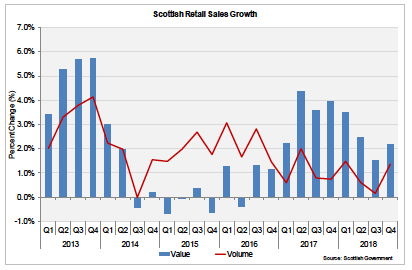
However, despite quarterly variations, growth for 2018 as a whole in Scotland was subdued, growing 0.9% compared to 2017 - it’s slowest pace since 2012 and notably below GB growth of 2.7%.
The slower sales growth in 2018 relative to recent years is consistent with the ongoing challenges on the demand side, with weakening consumer sentiment and subdued real wage growth weighing on household finances.
Looking ahead to 2019, the uncertainty associated with Brexit, and in particular a ‘no deal Brexit’ remains a key challenge for the retail sector, both in terms of the potential impact on consumer sentiment and demand and also the potential disruption to supply chains.
Labour Market
Scotland’s labour market has continued to perform strongly in the second half of 2018.
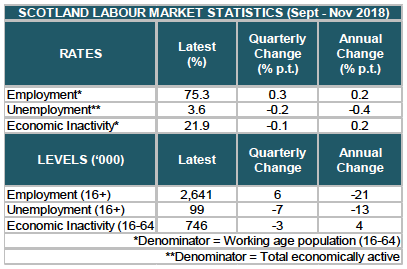
The unemployment rate has fallen to 3.6% (UK: 4%). This is the lowest rate recorded in Scotland and the number of people unemployed (99,000) has dipped below 100,000 for the first time.
Alongside the fall in unemployment, there has also been an increase in the employment rate over the past year to 75.3% (UK: 75.8%), which remains close to the record high achieved in 2017 (75.8%).
However, the number of people employed in Scotland has fallen by 21,000 over the past year, with full time employees falling by 15,000 and part-time employees by 7,000.
The reduction in the number of people unemployed and employed is reflected by a pick-up in the number of people economically inactive over the past year, which has increased by 4,000 to 21.9% (UK: 21.0%).
Tight conditions in the labour market continue to be reflected in business surveys, with firms reporting that vacancies continued to rise in January, albeit at a more moderate pace than in recent months. This, in combination with a decline in the availability of candidates, are signalling that recruitment conditions remain challenging for firms.
The declines in the number of permanent and temporary staff available in the face of rising job vacancies was accompanied by an increase in permanent and temp wages and starting salaries at the start of 2019.[3]
HMRC data[4] for Scotland show that average PAYE pay in April-June 2018 was 2.0% higher than a year earlier. This was down slightly from 2.2% growth in 2017-18 as a whole, however the pace of average pay growth remains notably higher than in 2015-16 and 2016-17.
Differences between Scottish and rest of the UK Revealed Comparative Advantages in exported goods.
The UK’s future trading relationship with the EU and other countries is uncertain, and the UK may have to renegotiate a number of trade agreements. It is therefore important to understand the composition of Scottish exports, and in particular how Scotland’s international trade may differ from the rest of the UK.
This box presents new analysis of Revealed Comparative Advantage (RCA) in exported goods. By looking at the RCA for Scottish and UK exported goods, we gain insight into the current strengths of Scottish trade and differences with the UK.
RCA is an indicator describing the extent to which one country has an advantage in exporting a particular good in comparison to the world average. It answers the question “Compared to the world average how much better is country A at exporting good Y”.
If a particular good accounts for a larger share of country A’s exports than it does to global exports, country A is said to have a revealed comparative advantage in the export of that good. An RCA value greater than one implies a comparative advantage for that good when compared to the world as a whole. Any value less than one implies a comparative disadvantage, and equal to one implies a comparative advantage similar to that of the world average.
The table of the top 10 goods that Scotland exports is displayed below. For comparison purposes, the indicator has also been calculated for the Rest of the UK. As an example, with an RCA of 23.1, Scotland exports 23 times its ‘fair share’ of beverages globally and 4.3 times its ‘fair share’ of fish and seafood.
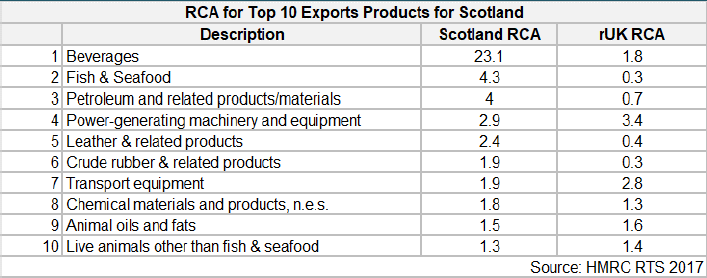
It is clear that Scotland has particular export advantages, notably Beverages, primarily a result of Scotch whisky. When comparing these indicators to the rest of the UK, the most discernible differences are in the exports of Beverages, Fish & Seafood, and Leather products, where Scotland clearly has a bigger comparative advantage than the rest of the UK.
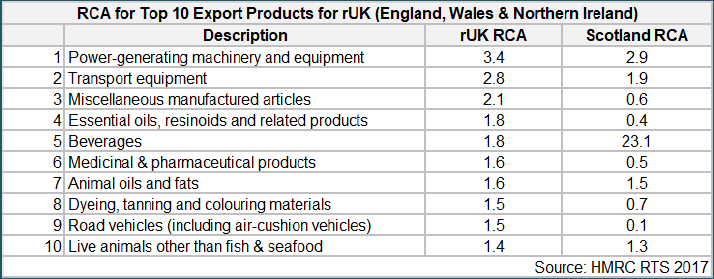
The differences between Scotland and the rest of the UK sector RCA’s can also be seen in the table below when considering the rest of the UK top ten export products.
While RCA has advantages in explaining Scotland’s relative advantages, it is important to also look at the absolute volumes of Scottish exports to gain a greater understanding of the Scottish context. For example, with Scotland having an RCA of 1.9 for Transport equipment, Scottish exports were worth £1.2 billion to the Scottish economy in 2017. In comparison, the Scottish exports of leather product exports, with a RCA of 2.4, were worth £110 million in 2017.[5]
Further detail on this analysis and new Computable General Equilibrium (CGE) sectoral analysis has been published alongside this report looking at the long term impacts of Brexit on the Scottish economy.
Labour Productivity
The continuation of more robust output growth over the past year alongside the continued strength in the labour market corresponds to the rebound in labour productivity performance over the period.
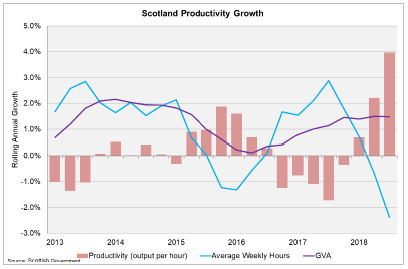
In Q3 2018, Scottish labour productivity growth (output per hour worked) was flat over the quarter, following growth of 0.2% in the previous quarter (trend-based).
However, despite the slightly weaker quarterly growth profile, on the more stable rolling annual basis (comparing the latest 4 quarters with the previous 4 quarters) labour productivity grew 4.0% over the period, accelerating over the year to its fastest pace of growth since 2010. This reflects that over the year, GVA grew 1.5% while the total number of hours worked fell 2.4%.
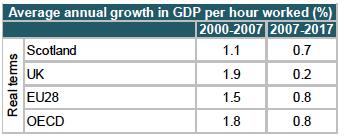
Recently released data from the OECD allows us to look at Scotland’s long term productivity in an international context[6]. Between 2000 and 2007, productivity in Scotland grew significantly more slowly than in the rest of the UK and across the OECD as a whole. Over the past decade this trend has been revised. Between 2007 and 2017, Scotland’s productivity growth has been noticeably faster than in the UK as a whole, and only marginally behind the OECD average.
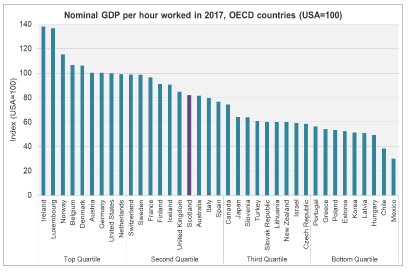
Scotland’s overall productivity (measured in terms of GDP per hour worked) ranked Scotland 16th (out of 37 countries) amongst the OECD member countries in 2017, placing Scotland in the second quartile of OECD countries.
Business Sentiment
The latest Scottish business surveys[7] have signalled further growth in private sector business activity in Scotland in the final quarter of the year, however, there are signals that the pace of growth has been moderating from earlier in the year.
The RBS Purchasing Managers Index reported slower growth across manufacturers and service providers in the final quarter of the year, with a broad based contraction across December and January. This reflected a drop off in new business/new orders growth.
Staffing levels however, appeared to hold up with firms taking the opportunity to clear backlogs of work.
This chimed with the signals from the Scottish Engineering Quarterly Review which reported a slowing of growth in output from the engineering manufacturing sector in the fourth quarter driven by a contraction in new orders, both domestic and exports.
The CBI Scottish Industrial Trends Survey also reported generally slower output and order growth during 2018 compared to 2017, however there were signs that output and new orders rallied in the 3-months to January 2019.
A theme across the business surveys is that business sentiment indicators have weakened during 2018. This is likely to reflect a combination of slower output and new order growth alongside the continued uncertainty associated with Brexit and the risks of disruption associated with a no-deal.
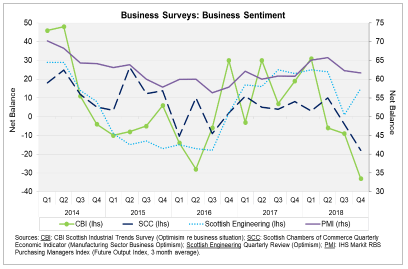
As a result, business capital investment remains fragile with the CBI Scottish Industrial Trends Survey reporting continued weakness in investment intentions over the next year and the balance of respondents in the Fraser of Allander Institute Scottish Business Monitor reporting a decline in capital investment.
The impact of Brexit uncertainty on business activity was also evident in the IHS Markit/CIPS UK Manufacturing PMI[8] for January which reported that business inventory holdings increased at the fastest pace in the 27-year survey history as stockpiling becomes more widespread.
While this may provide a short-term boost to economic activity, this may be partially offsetting the reduction in capital investment activity that may have occurred with less uncertainty. The latest Bank of England’s inflation report[9] set out that business investment in the UK has stalled since the EU Referendum with weak investment appearing to primarily reflect the associated uncertainty.
Alongside this, our modelling on stockpiling in the previous edition of the State of the Economy showed that in the medium term, the cumulative impacts of stockpiling before the UK leaves the EU are negative as the initial gain is more than offset by the unwinding of the inventory build-up going forward.
Exposure of Scottish Industry to Brexit
The UK’s exit from the EU will have different impacts on different sectors in Scotland. This box presents new analysis on the potential risks of a no-deal or a hard Brexit on different sectors of the Scottish economy.
Sectors most exposed to a no-deal Brexit typically fall into one of the following categories:
- A large proportion of their sales come from EU exports (e.g. chemicals);
- They export a lot to the EU in absolute terms, even if it represents a smaller proportion of their overall sales (e.g. food and drink);
- They are part of integrated EU wide supply chains (e.g. transport equipment);
- Are reliant on EU workers and free movement of labour (e.g. agriculture);
- Finally, some sectors will have less direct exposure, but will be susceptible to the wider economic slowdown that a no-deal Brexit would generate (e.g. construction).
The chart below shows different Scottish sectors on four different dimensions. The colour of the bubbles provides an assessment of their exposure to a no-deal Brexit using the above criteria. Each sector was plotted with its EU export proportions on the Y axis, its economy-wide employment levels on the X axis and its EU export volumes as the size of its bubble.
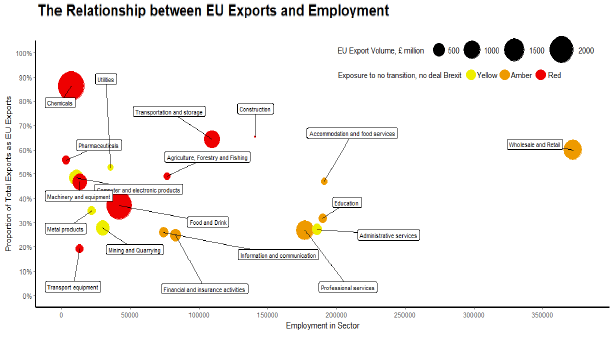
The proportion of EU exports tells us the reliance each sector has on the EU as an export market, while the volume of exports tells the relative significance of this compared to other sectors. The employment dimension helps illustrate the proportion of Scottish employment exposed, while the exposure indicator illustrates which sectors are particularly at risk.
For example, the Chemical sector in Scotland has a high reliance on the EU export market, and makes up a significant component of total EU Scottish exports. However, the sector’s overall employment is lower than many other industries.
Comparatively, the Food & Drink sector appears to be slightly less reliant on the EU export market, but still makes up a large component of total Scottish EU exports. It also has higher employment, suggesting that a larger proportion of Scottish employment will be exposed.
Likewise, although the Wholesale and Retail sector has lower EU export volumes than many sectors, any potential impact on the sector has the potential to be spread across a larger proportion of Scottish employment.
Consumer Sentiment[10]
Alongside softer business confidence in the latter half of 2018, consumer sentiment in Scotland also weakened in 2018 and fell to its lowest reading in the time series (-5.8) in the final quarter of the year.
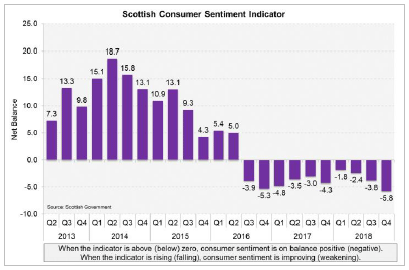
The Consumer Sentiment Indicator is made up of a number of different elements looking at both current sentiment and future expectations.
Current sentiment relating to economic performance, household financial security and attitude to buying, have strengthened over the course of 2018, though remain weak on balance. This is consistent with the generally stronger pace of growth in the Scottish economy and the strong performance in the labour market.
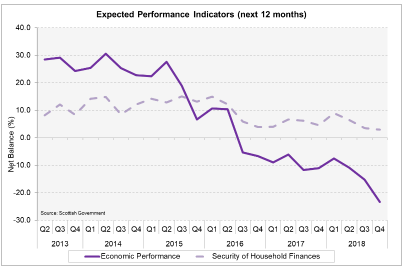
The deterioration in the headline indicator in 2018 has been predominantly driven by a fall in expectations for the economic outlook and household financial security over the next 12 months. In Q4 2018, both indicators fell to their lowest readings in the times series. It is reasonable to assume that this reflects households’ concern for the uncertainty and potential impact that Brexit could have over the coming year.
Whilst the full impact of Brexit on Scotland’s economy has yet to materialise, the fact that such concerns are reflected in consumers’ expectations could have an impact on current economic activity. For example, consumers may delay large purchases until the outlook becomes clearer. Alternatively, they may increase their savings with a corresponding reduction in current spending.
Scotland’s Economic Outlook
Looking forward, the latest independent forecasts of the Scottish economy reflect the stronger period of outturn growth in Scotland’s economy over the past 18 months.
However, in the absence of certainty regarding the terms of a Withdrawal Agreement and Future Economic Partnership between the UK and EU, all independent forecasts assume some form of smooth and orderly transition and as such have the potential to need revision once there is more clarity on that issue. Therefore, the forecasts do not reflect the outlook for the Scottish economy were a no-deal or hard Brexit to emerge.
The Scottish Fiscal Commission (SFC) forecast Scottish GDP grow of 1.4% in 2018 (revised up from 0.7% in May), followed by growth of 1.2% in 2019 and 1% per annum between 2020 and 2021. In the short run, this is broadly consistent with the Fraser of Allander Institute (FAI) forecasts of 1.3% in 2018 rising to 1.4% in 2019. However, in the longer term, the SFC forecasts are more cautious than other independent forecasters. For example the FAI forecast growth of 1.5% in 2020 and 1.4% in 2021.
The table below sets out a selection of independent forecasts and projections.
| Independent Scottish GDP Growth Forecasts (%) | |||||||
|---|---|---|---|---|---|---|---|
| 2017 (outturn) | 2018 | 2019 | 2020 | 2021 | 2022 | 2023 | |
| Scottish Fiscal Commission | 1.5 | 1.4 | 1.2 | 1.0 | 1.0 | 1.1 | 1.2 |
| Fraser of Allander Institute | 1.3 | 1.4 | 1.5 | 1.4 | - | - | |
| EY ITEM Club | 1.6 | 1.0 | 1.4 | 1.5 | 1.7 | - | |
| PWC | 1.5 | 1.5 | - | - | - | - | |
The key risk to Scotland’s economy over the next 6-12 months remains the uncertainty associated with Brexit, and in particular the risk of a no-deal, which is impacting on business confidence. There is increasing evidence that the lack of business confidence as a result of the uncertainty surrounding the Withdrawal Agreement and Future Economic Partnership, is featuring through increasing stockpiling and reducing investment intentions. This has the potential to create some volatility in the economic data over the coming months.
Contact
Email: Office of the Chief Economic Adviser OCEABusiness@gov.scot
There is a problem
Thanks for your feedback